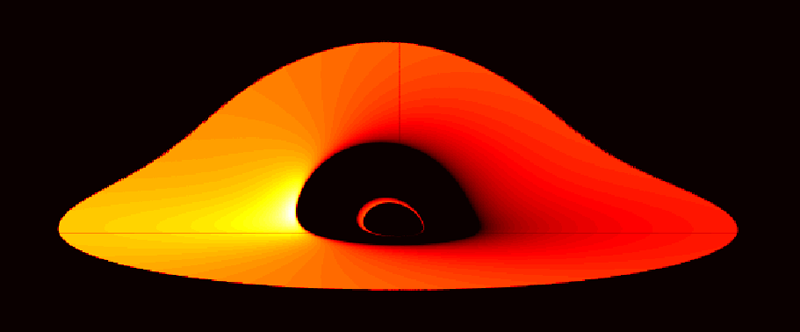by Dan Wilkins

Supermassive black holes power some of the most luminous objects we see in the Universe. When material spirals into a supermassive black hole in the center of a galaxy that is in excess of a million Solar masses, it gives rise to an active galactic nucleus, or AGN (also discussed in two previous KIPAC blogposts: this one focused on observations of flaring from AGNs, while this one focused on simulation aspects).
In addition to spewing electromagnetic radiation running from visible light through ultraviolet all the way to X-rays and gamma rays, many AGN can launch jets of particles at close to the speed of light. These jets are detected through the radio waves they emit by synchrotron radiation and can extend between 50 and 100 kpc (about 150,000 to 300,000 light years) from the central black hole. All this activity occurs in and around the so-called accretion disc: the flattened disc of gas that is spiralling into the black hole, just moments before it plunges through the surface of no return, the “event horizon” of the central massive black hole. The vast energy spewing forth from the accretion disc region indicates that AGN are a critical component in understanding the formation of structure in the Universe.

Figure 1. Artist’s impression of the corona of energetic particles that produces intense X-ray emission from an AGN as a jet-like structure is launched. Detailed observations of the X-ray emission enable astrophysicists to build up a picture of the corona showing how corona material that is initially extended over the surface of the black hole’s accretion disc becomes gathered up in the central regions during the flare and then launched like a jet. In this illustration the launch is aborted and the corona collapses back down (see later in body of this article to understand why we would focus on this scenario). (Image credit: NASA/JPL-Caltech/R. Hurt.)
However, a great deal of mystery still surrounds these impressive systems. We still don’t understand exactly how energy is extracted from the material as it falls in under the strong gravity of the black hole. We do know that a crucial piece of the puzzle is a structure outside the black hole known as the corona: this is a super-heated region that produces the intense X-ray light. At the same time, the precise mechanism that launches the jets at close to the speed of light is unknown, it is likely that the corona plays an important role which astrophysicists at KIPAC are starting to learn about for the first time.
The corona is formed from energetic particles in the extreme environment right outside the black hole’s event horizon. There are two possibilities for its structure; either it sits covering the innermost parts of the inspiralling accretion disc or it is located at the launching point of the jet where—in addition to being heated by the gravitational energy released as the disc material falls in—it can tap energy from the spinning of the black hole itself (see Figure 2). Our latest research suggests that the corona is, in fact, a combination of both of these structures. Although we know the corona is responsible for a significant fraction of the energy output, the mechanism that energizes these particles remains a mystery. The intertwining of magnetic field lines that are generated in the accretion disc, and their eventual breaking and reconnecting is widely believed to be responsible for this (this same process, seen at a much lower energy, is commonly associated with energetic particles flung out in solar flares from the Sun’s corona).

Figure 2: Schematic of the innermost regions around the supermassive black hole in an AGN. The infalling material forms a flattened accretion disc through which the material spirals inwards until it gets to a radius where it can no longer orbit stably around the black hole, at which point it plunges straight through the event horizon (the surface of no return) of the central massive black hole. Extreme amounts of energy are released as this material falls inwards. Some of this energy is injected into the corona where through the intertwining and breaking of magnetic fields it super-heats particles. The corona could possess one of two configurations, either (left) crowning the inner parts of the accretion disc or (right) sitting at the launching point of a jet of particles that are spewed outward at close to the speed of light. The corona also produces intense X-ray radiation, some of which shines onto the accretion disc whereupon we can see its reflection. (Credit: D. Wilkins.)
The X-rays that are emitted by the material falling into the supermassive black hole provide us with a unique probe of what is happening in that extreme environment, right down close to the black hole’s event horizon. These emissions are incredibly variable. The corona is typically millions of kilometers (i.e., tens of light minutes) across, yet incredibly active, with the intensity of the emissions we detect varying by factors of two, three, or more on timescales of just hours On some occasions the x-ray intensity will even suddenly flare very intensely.
Some of the X-rays that are emitted from the corona shine back down onto the disc of inflowing material and are reflected. Astrophysicists at KIPAC are able to use these reflected X-rays to probe, in detail, how the corona behaves and evolves over the course of some of these impressive X-ray flares. Different atoms in the inflowing disc, when illuminated by X-rays from the corona, reflect these X-rays at specific energies. The X-rays that reflect off the accretion disc must pass through space and time that has been severely curved by the extreme gravity of the black hole (Figure 3). This path through curved space-time bends the paths of the X-rays and shifts their energies (the energy of an X-ray can be thought of as analogous to the color of a specific wavelength of visible light). By measuring the shift in the X-ray energy by the time it reaches our telescope, as well as keeping track of the time delays between reflections from different parts of the disc (i.e., how long it takes the X-rays from the corona to reach different parts of the disc), we can see the echoes as the X-rays reflect off different parts of the disc, allowing us to build up a picture of the inflowing material and of the corona.
Emissions from close to the supermassive black holes in a number of AGN are monitored regularly with NASA’s Swift satellite. On a growing number of occasions, this monitoring has revealed sudden flares in X-ray emissions where the brightness spikes by an order of magnitude or more, which has prompted detailed follow-up observations using large X-ray observatories such as Chandra, XMM-Newton and NuSTAR. One particularly fascinating example of a flare was seen by Swift from an AGN called Markarian 335 in September 2014. The X-ray emission was seen to increase by a factor of 10 for a period lasting a few days, leading to a follow-up observation with NuSTAR.

Figure 3. X-rays that are reflected off of the disc of inflowing material pass through the curved spacetime in the extreme environment around the black hole. This causes the paths of the X-rays to be bent (letting us see the back side of the disc lensed into view above the black hole in the image) and the energy of the X-rays that reach us to be shifted. Measuring the specific energy shifts of the X-rays we see and the time delays between them lets us build up a picture of the inflowing disc and of the powerful corona around the black hole. (Image credit D. Wilkins.)
It was discovered during this particular flare that the corona evolves in a particularly fascinating way. Before the flare started, the corona of energetic particles that produces the intense X-ray emission was spread out over the inner part of surface of the inflowing disc of material, but as the flare began, the corona became gathered up in the center and was launched away from the black hole at about 20 per cent the speed of light, reminiscent of the jets seen from some AGN. Although Markarian 335 is not normally known to possess a large jet as some other AGN do, it is as if during this flare, it tried to launch a jet but could not sustain it and the corona, running out of energy, collapsed back down to a very small region around the black hole. (See Figure 1, above, for an artist’s impression of this process.)
While the 2014 flare was a particularly extreme example, more recent studies at KIPAC, to be published over the coming months, suggest that in other AGN, this collimated base of a failed jet embedded in the centre of the corona (even when there is no large-scale jet) is a common feature. Flares are seen to originate in the outer parts of the corona, above the inflowing disc. When they occur, magnetic fields that inject energy into the corona become more active, increasing not only the X-ray brightness but how rapidly it flickers. As the flares continue to evolve, the baton is passed into the jet-base at the core where the launching of material leads to a sudden spike in the X-ray brightness.
Observing the behavior of the corona during flares is giving important insight into exactly how it is energized and is even starting to give clues about the process that launches jets. We are starting to discover how the vast jets seen from some AGN may be linked to the corona. With the large number of discoveries that have been made in recent years and with the large, state-of-the-art X-ray observatories planned for the coming decade, exciting prospects lie ahead for understanding precisely how black holes are responsible for some of the most powerfully energetic outflows we observe in the Universe.
----------- Further reading:
Towards modelling X-ray reverberation in AGN: Piecing together the extended corona (D. Wilkins et al. (2016))
Flaring from the supermassive black hole in Mrk 335 studied with Swift and NuSTAR (D. Wilkins et al. (2015))






